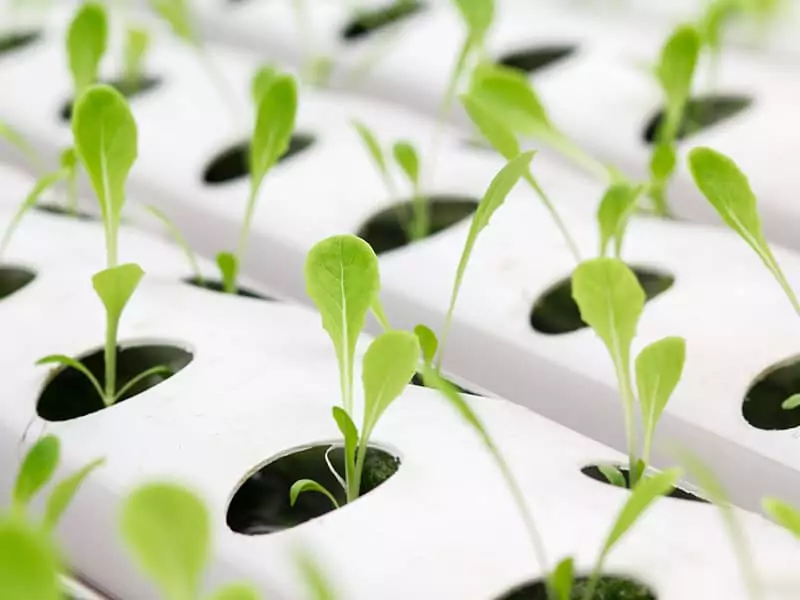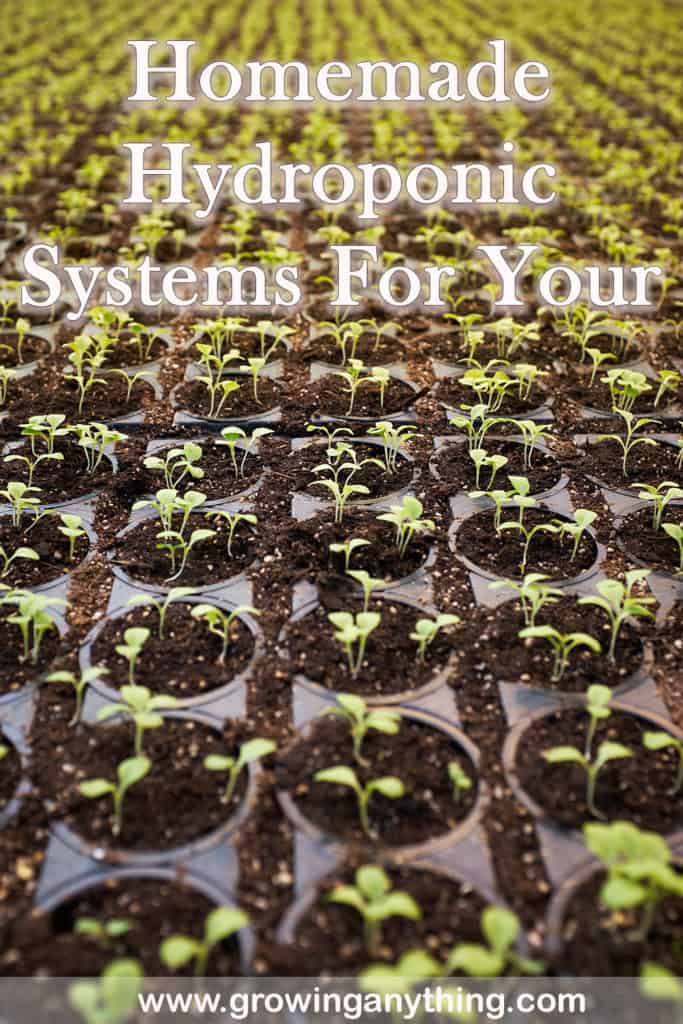18 Homemade Hydroponic Systems
Homemade hydroponic systems are the future of urban gardens. So, if you are looking for a way to build a modern and effective hydroponic system for your plants, the article is for you!
Let me show you ways to build a system of your own, which depends on your needs, available space, and skills! You can start with a simple wick system, Kratky method or put all your efforts into building something more complex, such as the Nutrient Film Technology (NFT) system.
Essentially, a hydroponic system helps you grow plants indoors, or outdoors without the soil and complex maintenance. Also, with these systems, you can expect fewer problems with pests and weeds compared to standard soil gardens.
So, let’s talk about the best DIY hydroponic systems!

1 Classic Hydroponic System
I won’t explain the science between this easy DIY hydroponic system, I will go straight to the things you need. Luckily, these are all affordable items, you probably have at your home already.
You’ll need one larger and one smaller bottle, caps, glue, the hose for the aquarium, paint, tape, and perlite. The first thing to do is to join two caps with glue. Make a hole and fit the aquarium hose till it reaches the bottom of the bigger bottle.
Use the larger bottle as a reservoir and fill it with perlite! Mount the smaller bottle on the larger one and watch your system work.
Find the step-by-step tutorial on how to make this system.
2 Modern Indoor Hydroponic System
The next system relies on the premise that you have ensured the source of light indoors and a well-leveled surface. Fill the water tank with nutrients and ensure it is waterproof. Prepare the plants and put the styrofoam in the tank. Be gentle, and try not to tear it up.
The key step is to ensure the airline goes through the hole in the reservoir.
Find out what else you will need to make the system work!
3 Hydroponic System for Kitchen Herbs
The next system includes a mason jar, a net pot, rock wool cube and clay pellets. You’ll also need hydroponic nutrients, seeds, a plastic bag, and paint. The system is easy to build because it is a variant of the popular and simple Kratky method developed without tools and electricity.
Paint the mason jar in multiple coats to improve its efficiency. Put the seeds in the rock wool cube and wait for them to develop sprouts.
From this point, you can fill the mason jar with reverse osmosis and add the nutrient solution. All it is left is to put the seeds in the net pot, then into the mason jar, screw the lid and expose the system to light!
Find out if Mint will grow well in this system!
Discover the simplest tutorial for the Kratky method
4 Cheap, Easy to Transport System
The next system is suitable for those who want a quick, compact, and inexpensive solution for getting familiar with hydroponic gardening. You’ll need a plastic container, an empty bottle sliced in half, a cheap aquarium pump, and only basic tools.
The system is easy to transport and it can be expanded to support more plants.
Here is what you need to get started with simple hydroponic gardening!
5 Kratky Method with a Glass Bottle and Stone Wool
Do you have an old glass bottle of juice or drink? You can use it for this simple Kratky hydroponic system. For this method to work, you’ll need to prepare stone wool as growing media. Leafy green and herbs, such as basil, grow the best with this static water system.
6 Expandable Hydroponic System
The next system works great because it is expandable and features a simple and achievable design. When you wish to expand your plant collection, you’ll have to get additional pipes. Put the container in the bottom as well as the aquarium pump, and use hydroton pellets as growing media.
Find out if hydroton pellets are really that good!
7 Solution for Aquatic Plants
If you are into aquatic plants for example watercress or water spinach, you probably know that these will thrive in hydroponic systems.
You can easily make your own system using a bowl with a lid. Poke holes in the lid and put the roots of the plants through them. Fill the water bowl with water and hydroponic fertilizer and that is all!
Read the most important advice on growing aquatic plants hydroponically!
8 DIY Hydroponic Tower For The Lack Of Space
Modular hydroponic systems are great for limited space. Here is an idea for a hydroponic garden you love! I recommend you build the one from sturdy material, such as wood or a PVC pipe, so it can hold the weight. You’ll also need a water pump, tubing, nuts, threaded rod, silicone sealant, and several other items.
The easiest way to get the fitting plant cups is to use a 3D printer.
Here are 7 detailed steps to build a modular hydroponic system.
9 Fool-Proof System
The next method is a simplified version of a Kratky system in gardening terms. It is also one of the easiest ones to create at home, and perfect for growing tomatoes. It doesn’t require you to use tools or electricity, just your creativity!
You’ll need a bucket, a designated hydroponic fertilizer, hydroton, plants, a cup, and of course water! Drill the holes in the cup, bury the bucket in the ground and use hydroton as a growing item.
10 NFT Hydroponic System
The next one might be too complex, but it is worth the effort. The NFT hydroponic system consists of several PVC pipes with designated holes for the plants.
You’ll also need a pump, a water tank and an LED bar to ensure proper lighting for the plants. The beauty of the system is that once established, it becomes a low-maintenance system.
If you get everything right, you can even install the system in the basement!
Find out which plants grow best in the NFT hydroponic systems.
Find out how to make the hydroponic system from PVC pipes
11 Net System
Instead of building a system with a net pot, you can make your own system with a fishnet and recycled plastic bottles. The system is great, because it allows you to adjust the opening, and by so, control the evaporation.
The basic things you need are bottles, nylon mesh, and scissors, as well as the water container, a hose, and a pump. Cut the section of the net and use a plastic ring from the bottle to customize the opening. Then, cut the bottle and put the mesh on top of the bottle, alongside the plastic ring. Fill the mesh with growing media and seedlings.
Analyze the net system so you can replicate it easier!
12 Use Fish Tank
If you already have a fish tank with fish, why not use it for your hydroponic crops? The water from the tank should provide all the necessary nutrients for your plants. For example, the animal waste contains high levels of ammonia, which is often used to fertilize plants.
The system is very simple because you already have most of the things you need. Add a plate with holes and cups with plants on the top of the aquarium and connect them with a pump and there you have it!
Read the most comprehensive handout for hydroponic gardening ever!
13 Hydroponic System For Orchids
Orchids can be challenging to grow. But with this hydroponic system, you have better chances to keep them alive. The system consists of clay pellets and allows the roots to grow into the water while having enough air circulation at the same time.
Not all orchids will grow successfully in a system like this, but some will thrive!
You’ll need a liner pot and a decorative pot. After you assemble the system, keep an eye to see how your plants respond to it.
14 Hydroponic System in a Tub
To build a simple hydroponic system with a tub, you’ll need a container with nutrient-rich water. The container needs to have a lid for this method to work. Then, put the plant in the net pot, which you will put in the hole in the lid. That way, the pot will touch the water, and as the plant matures, it will develop oxygen roots, small horizontal roots which absorb oxygen.
Therefore, don’t fill the air gap that develops, if you don’t want to drown your plant! You can try this system with lettuce seedlings, it will work like a charm!
But, before that, find out exactly how to build the system, step by step.
15 DIY Dutch Bucket System for Your Vegetables
The Dutch bucket hydroponic system includes several 2.5-gallon buckets and is best suitable for crops, such as tomatoes, roses, etc. Each bucket needs to hold the nutrient solution in addition to a single dripper, which drains through the bucket with a standard PVC pipe.
The key for this system to succeed is to put the nutrient bucket below the draining pipe, so gravity will do its magic and carry the nutrients back to the bucket. Use a pump to ensure recirculation, so the solution goes back to the dripper and continues the feeding circle.
Here is what you need to know about the Dutch system, explained in detail.
Have a closer look at the process of making a Dutch system for your plants.
16 Hydroponic Fodder System
The next system is simple and requires a shelf and a pump. You can get as many bins as you need for the seed sprouting. Then, drill several small holes in every bin. Ensure the holes are smaller than the seeds, so the seeds won’t fall through the holes!
Tipp the bins up, to ensure a well-draining system and reuse the water for the bins below. The system is known as the fodder system, and many people use it to grow barley grass for their animals.
But, with this system, you’ll have to water the plants every four hours.
Here is how you can make the automated system if frequent watering seems too tiresome for you.
17 Simple Hydroponic System for Balcony
Growing your plants on the balcony is an excellent way to grow your own food. What do plants need? They need water, sunlight, and soil. By installing the hydroponic system on the balcony you eliminate the soil and sunlight from the equation.
You can make your hydroponic cups with standard plastic cups and use standard food containers. Just drill the holes. Next, you’ll have to invest in a good water pump, the shelf that will hold the entire construction, and the growing media, such as clay balls.
18 Practical and Decorative System
For the next system, you can use the old whiskey bottles. Turn them upside down, and connect them with a chain to create a vertical hydroponic system. You can use it to grow veggies and herbs. The ideal location for the system is a sunny window.
Find out which plants will grow like a charm in a system like this!
Grow Your Own Food With Hydroponic System
Hydroponic systems are your way to expand your gardening options and grow your food even if you live in a small apartment, without a balcony or garden.
Sure, you can get commercial hydroponic kits which are great for beginners and experienced gardeners. But, where is the fun in that? With my 18 ideas, you get to build a perfect DIY hydroponic system, both effective and simple to make.
Which system will you try first?
If you think the article is useful, please hit the like button!

